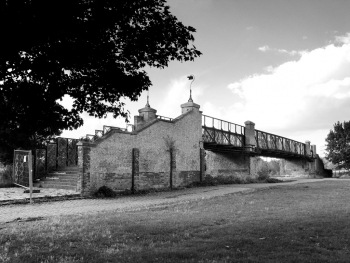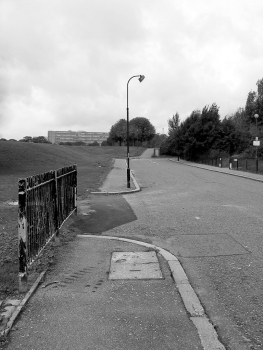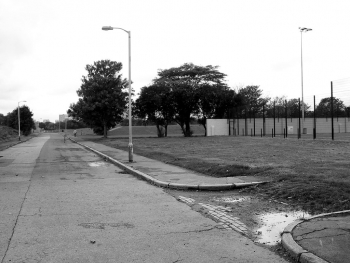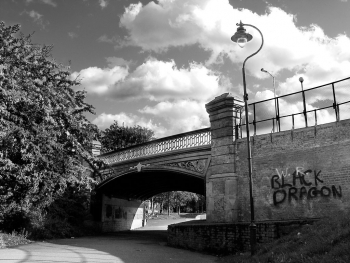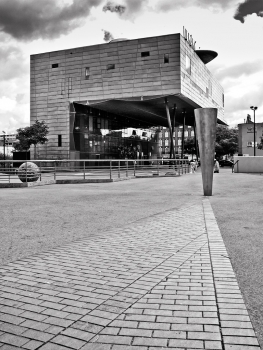1888: PC Thomas Dean, drowned in the Grand Surrey Canal at Deptford, while patrolling his beat on a foggy night.
Metropolitan Police Roll of Honour
In the middle of Burgess Park is a footbridge. Wide stone steps lead up at one end, and down again at the other. There are two intermediate brick piers, for this isn’t a straight-up straight-down bridge; it could span a dual carriageway with ease. There’s also, half blocking the steps at the southern end, a metal barrier to which someone has stapled a notice saying Danger, Unsafe Structure. But, if you ignore this, and go up – treading carefully, as the paving, though safe, is rather cracked, and bearded with green – you can look down through the rusted lattice that edges the bridge’s walkway, and see what lies beneath.
What lies beneath is grass, and a cycle path running straight as a tightly wound rope.
This morning, a gentleman of the name Clitheroe, about twenty-four years of age, and who resided at Camberwell, was drowned in the Surrey Canal. The young man with some friends was skating on the Canal, when the ice gave way.
The Chronicle, March 1840
Burgess Park is big – twice the size of St James’s. But it has no pelicans, and no page in the history books. No richly bewigged queen ever hunted deer from Walworth to the Old Kent Road. No shirtsleeved king, his still-faithful dog at his side, was ever escorted down Wells Way for one last appointment with an axe. No prime minister ever strolled here, contemplating Germany, and war. It’s never had any of that nonsense. What Burgess Park does have, most definitely, is grass. And in that grass are, unmistakably, the ghosts of abandoned roads: cracked tarmac and kerbstones, carless and homeless, fading to brown and green. And here’s the thing: if you look in an old A-Z – one from the sixties, say – Burgess Park isn’t there. But those spectral streets are; and they have names, and purpose, and they’re drawn in hard black ink. There’s also a line of turquoise, running dead straight between them. Pretty much, in fact, exactly where the cycle path through the grass below the footbridge now runs.
At Lambeth Police Court yesterday afternoon, John Amos, aged 25, living at 6, Dean’s-buildings, Walworth, chocolate maker, was placed at the bar before Mr Chance, charged at the instance of Chief Inspector Davis, of the P Division, with causing the death of his wife, Elizabeth Amos, by pushing her into the Grand Surrey Canal on the morning of the 8th instant.
The Times, 15th September, 1874
The idea was a grand one: dig a ditch across Surrey, fill it with water, and sail boats down it from Epsom to the Thames, bringing cauliflowers and cabbages to the sooty, scurvy folk of London town. They called it, naturally, the Grand Surrey Canal. By 1809, having started at Rotherhithe, they’d got as far as Camberwell – to Addington Wharf just by Albany Road. In 1826, a second branch reached Peckham. It’s hard now, walking up Rye Lane, to equate Peckham with Antwerp, but when they built the new market square and library a few years back, those tasteful granite slabs were laid over a stub of road still defiantly called Quay Head. There was also, briefly, a link to the Croydon Canal at New Cross Gate. But the Croydon Canal was always a runt; just twenty-seven years after the first barge was loaded with lime from the Merstham quarries, the London and Croydon Railway put down sleepers where the water had been; and in the old dock’s musty hollow at the southern end, they built West Croydon station.
1877: PC Thomas Groomes, drowned in the Surrey Canal apparently attempting to arrest or rescue a thief he disturbed.
Metropolitan Police Roll of Honour
The Grand Surrey Canal never made it to Epsom. It never made it west of Camberwell Road. New plans were drawn up for an extension to Vauxhall, and back the other way to Deptford; by lopping off what was felt to be a largely ceremonial loop of the Thames, the canal could become a South London Suez, a Peckham Panama. Such grand ideas! All that actually happened was that the Rotherhithe end got enlarged to make a proper basin, with big gates to hold back the Thames. They called it, of course, the Grand Surrey Basin, and it gave others an idea: soon, nearly four hundred muddy acres of that desolate peninsula had been reinvented as the Surrey Commercial Docks.
In 1825, just as Stockton-on-Tees and Darlington were being joined by the world’s first steam passenger railway, someone had the idea of linking Rotherhithe to Portsmouth by a ninety-mile lockless cut; this vision they proudly entitled the Grand Ship Canal.
Burchell, Arthur. Police Constable. Case 39185. On the 29th June 1912, a man named Gillespie fell into the Grand Surrey Canal, Peckham, the night being dark and the depth 12 feet. Burchell went in fully clothed and succeeded in bringing him out.
Citation from the Royal Humane Society Annual Report, 1912
But the ships from the Solent, like the cauliflowers and the cabbages, never arrived. Instead, the South Metropolitan Gas Company used London’s Grandest Canal to ferry coal to their Old Kent Road gasworks (the gasometers are still there, behind PC World). And softwood, newly chopped from Baltic forests, came down to Peckham and Camberwell on horse barges from the timber ponds at the new Surrey Docks. By the mid 1830s, all dreams of Epsom, let alone Portsmouth, were gone, and the canal had become little more than a chain of wharves, a stunted adjunct to the docks it had helped found. In the mile and a quarter between the gasworks and Camberwell Road, the 1871 Ordnance Survey map shows the towpath lined with: a sawmill; a whiting works (grinding chalk for whitewash); an India rubber works; four timber yards; two ice warehouses; a wool works; manufactories for cabinets, tablecloths and floorcloths; two coal wharves; a colour works; a lime works; three stone yards; two breweries. Just back from the water’s edge, meanwhile, are tanneries, parchment makers, japanning works, ginger beer manufactories, bookbinders – and, rather intriguingly, a mineral water bottling plant. Even then, there were Del Boys in SE15, bottling Peckham’s finest. Indeed, this being south-east London, the Grand Surrey was the first canal in Britain to have its own police force: the bank rangers.
Richard Farris, labourer, was drowned in attempting to save a girl who had thrown herself into the canal at Globe Bridge Peckham, May 20, 1878.
memorial plaque in Postman’s Park
In December 1970, the whole of the Surrey Commercial Docks was closed. Bang, just like that, gone. Lavender Dock, Stave Dock, Albion Dock, Island Dock, Lady Dock, Russia Dock, Canada Dock, Greenland Dock, Norway Dock, South Dock – and the Grand Surrey Basin, where it had all begun. Uselessly, the old canal waited, stagnated. One evening, two young brothers playing on the mouldering quayside lost their footing, fell, and drowned. Their father, distraught, took a knife. People who believe in such things say his ghost still haunts the old towpath, searching for his missing sons; trying to pick them out in the crowd.
In 1974, the Grand Surrey Canal was drained.
1858: PC William Wilson, found drowned in the Surrey Canal, Camberwell, after being missed from his beat during a gale.
Metropolitan Police Roll of Honour
And, once the water was gone, the grass could come. Burgess Park had been intended for years, it was part of the post-war Abercrombie Plan, and small pockets of “open space” had been bit-by-bit set aside. Now, at last, they could be linked, and lovely fresh grass allowed to swarm all over the old roads that no one needed any more: Harling Street, Cunard Street, Jardin Street, Herring Street – the names are taken from that sixties A-Z; it’s not so long ago. They cleared 2,000 houses – some bomb-damaged, some slums, some just in the way – and shipped their residents off to haunt the windy balconies of the Aylesbury Estate, whose first grim blocks, like great ghostly liners, were already moored up along Albany Road.
I wonder why people are always blown into the Surrey Canal, and into no other piece of water! Why do people get up early and go out in groups, to be blown into the Surrey Canal? Do they say to one another, ‘Welcome death, so that we get into the newspapers’?
Charles Dickens, The Uncommercial Traveller
Surrey Canal Road, by the new Millwall ground, commemorates the route; it is, one notes, not grand. And though Evelyn Street still rises and falls as it always has, if you stand at the brow, and peer over the wall, there are no barges milling in the dip below, just the usual nondescript sheds of light industrial development; there are more of them further west, straggling in a suggestively purposeful line along Verney Road. Behind Peckham library, tastefully landscaped and planted with benches, an unexpected filament of grass ribbons north through the trees; alongside it, a block of flats bears the name Boathouse Walk. Canal Street still runs 50 yards off Albany Road, then stops dead at the empty waterfront. To its left, hidden away in a little hollow, is an old lime kiln.
And in Burgess Park there’s a footbridge; for ghosts to cross over the cold dark water, from one side of the smothering grass to the other.

